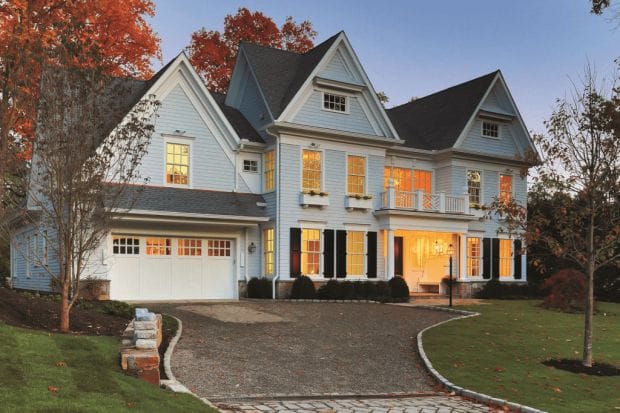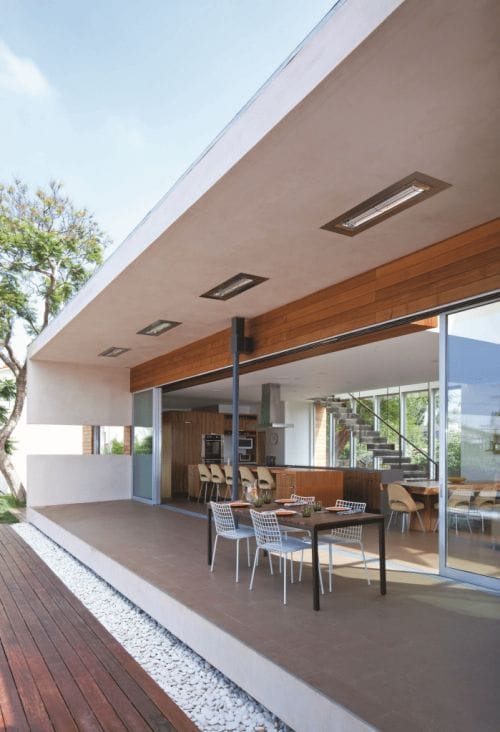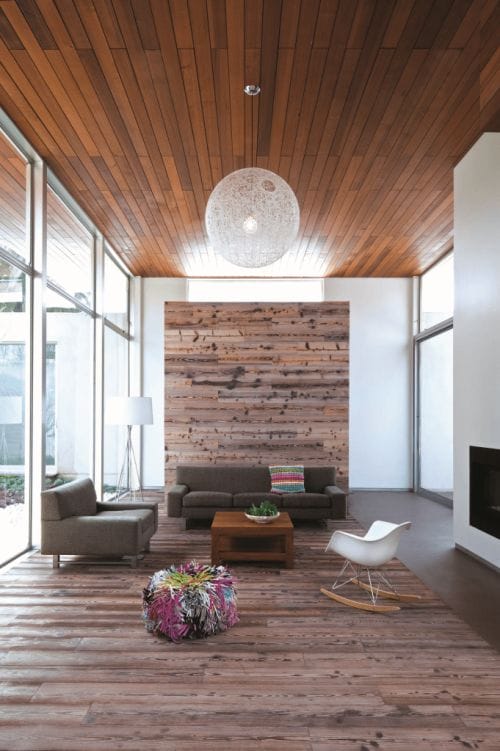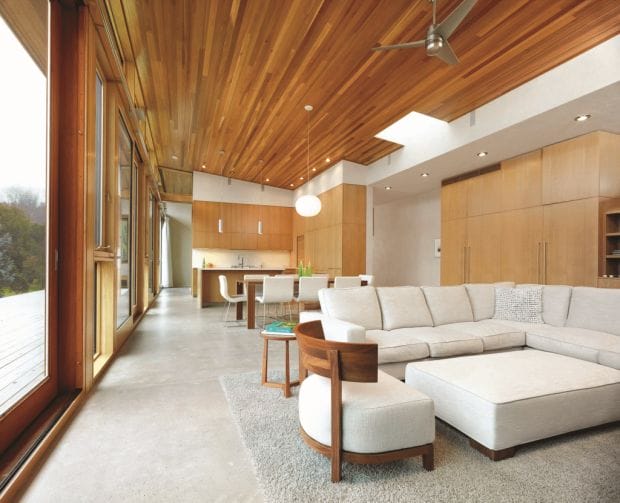Our columnist discovers four stunning properties that illustrate how superb design can mesh seamlessly with cleaner air and greener living. But most remarkable of all is what these homes do NOT have: loads of VOCs and respiratory triggers.
Park Passive House
Seattle, Washington
 This energy-efficient home features a top-notch ventilation system. Photo: Aaron Leitz
This energy-efficient home features a top-notch ventilation system. Photo: Aaron Leitz The pair opted for a passive house, a building style that is increasingly common in Europe and is now gaining popularity in North America. Put simply, these are ultra-low energy buildings that require almost no heating or cooling, and use almost no energy from fossil fuels to heat air or water.
In fact, the Park Passive home’s heating system, when turned up to high, only consumes about the same amount of electricity as a hair dryer.
That’s no small feat: especially in a wet, chilly climate like Seattle, it meant triple-paned windows, plenty of insulation – in some spaces up to 28 inches thick – and a complex ventilation system. But the design wasn’t just about going green. With two young kids, the couple also wanted to ensure the home was as healthy as possible. And while many expect that level of green to take a big bite out of their budgets, Sloan Ritchie says it only cost roughly 5 to 10 percent more than a conventional house – and energy bills are a fraction of what they used to pay.
Heating/Cooling/Air Filtering: Because the home is so tightly sealed for energy efficiency, a top-notch ventilation system was essential. There are actually two systems: a ductless mini-split (or heat pump), which uses roughly two-thirds less energy than a typical heating system, as well as a heat recovery Ventilator, or HRV that continuously delivers fresh, filtered air in and exhausts stale air out.
Flooring: On the ground level, the pair opted for polished concrete – a durable surface that requires no maintenance, offers a sleek, timeless look, and avoids the dust mites, mold and VOCs (volatile organic compounds) that come with carpeting. The stairs are hardwood, taken from an ash tree that had to be removed from the site, and that the pair had milled. Upstairs, the flooring is solid bamboo, with ceramic tile in the bathrooms.
 Upstairs, allergy-friendly bamboo flooring complements the open concept layout. Photo: Aaron Leitz
Upstairs, allergy-friendly bamboo flooring complements the open concept layout. Photo: Aaron Leitz Wall Finishes: The walls are gypsum board (or drywall), painted with Sherwin Williams’ ProMar 200 – a professional-grade zero-VOC interior paint. Some accent walls also feature wood panels made from the ash tree removed from the site.
Insulation: The main aim of a passive house is to limit energy use, so insulation is key. The Park Passive house features a whopping eight inches of EPS foam insulation underneath the slab foundation, as well as blown-in dense-pack fiberglass in the walls. There’s also a 5.5-inch layer of dense-pack fiberglass insulation on the interior wall, and another nine inches to the exterior, for a total of 15 inches. And while fiberglass often gets a bad rap for its formaldehyde content, Ritchie made sure theirs was formaldehyde-free.
Design Extras: The three-story modern home also features a day-lit open stairwell, double-height vaulted kitchen ceilings and an open floor plan. But what’s really jaw-dropping is the efficiency: it uses 90 percent less energy than a typical home.
“One of the things I like the best is it is very quiet, because we’ve got triple-paned glass, very thick walls and it’s airtight,” says Ritchie, who now builds similar homes for clients. “Even if it’s cold and dark outside in winter, it feels very comfortable inside because there are no drafts. You can wear shorts around the house year-round, it’s so comfortable,” he adds with a laugh. “It’s just a great place to live.”
Kent Road
Scarsdale, New York

It was eight years ago that Jan Flanzer discovered her house north of New York City was contaminated with toxic mold – an infestation that left her and her family sick, sensitive to indoor pollutants, and seeking a healthy home. That search turned into a Scarsdale-based business called Healthy Home Builders, and now Planzer, along with contractor Peter Donovan, have made it their life’s work to build homes that are focused on clean air, pure water and cost-saving energy.
“We have choices about the food we buy, and the clothing we wear. We want to make sure people know they have a choice about where they live, too,” Flanzer says. “Most new construction is full of toxic chemicals – unless you specifically research and find products that are as good or better, and don’t have the chemicals in them. That’s what we do.”
Kent Road is a six-bedroom, seven-bath, colonial-style home that has a warm, traditional look, but inside the home also offers state-of-the-art technology that maximizes energy efficiency, water purity, and above all, air quality.
Heating/Cooling/Air Filtering: The house features whole-home HEPA filtration and an energy recovery ventilation (ERV) system that ensures a steady supply of fresh, filtered air. A garage exhaust ventilation system also keeps carbon monoxide, benzene and other harmful elements of car exhaust from entering the home.
 Solid maple cabinets are free of finishes.
Solid maple cabinets are free of finishes. Cabinets and Counters: All of the cabinets were custom-made from solid maple in upstate New York – minus any harmful stains and coatings. “Cabinetry is usually the most dangerous, in terms of reactions and toxins, because if it’s not custom cabinetry that’s solid wood, it can have toxic glues and formaldehyde,” says Flanzer, “and that is just brutal to off-gas.” The countertops are made from Absolute Black granite.
 Floors are built from reclaimed wood with chestnut stain rated zero for VOCs.
Floors are built from reclaimed wood with chestnut stain rated zero for VOCs. Insulation: Recycled denim insulation by UltraTouch was the insulation of choice, both because it doesn’t contain harmful chemicals, and because it provides great sound deadening. Elsewhere in the home, the designers used blown-in cellulose, a non-toxic insulation made from recycled newspaper.
Design Extras: The home has a host of other features, among them a solar hot-water heating system, a whole-home carbon water filtration system, and a cistern for collecting and recycling rainwater.
At every step, the subcontractors had to use only products that Flanzer, Donovan and their team had sourced. “If they had slipped up with one little product because they ran out of something and went to get another half-gallon of paint that wasn’t the same, it could have cross-contaminated the whole job,” Flanzer says: “So we had to be really careful.”
Appleton Living
Venice, California
 Open spaces are knit together by bamboo and walnut. Photo: Art Gray
Open spaces are knit together by bamboo and walnut. Photo: Art Gray The home is oriented so that all the rooms enjoy the stunning outdoor living space, which includes a pool, an outdoor dining area, barbecue and play court. But it’s not all about aesthetic appeal; the house was designed to take full advantage of passive solar principles, as well as natural ventilation.
And while its look is decidedly modern, natural elements such as wood and stone bring it back down to earth, giving it a warm, inviting feel. It also had to be extra durable, functional, livable and easy to clean, because the clients are a busy family of six who also foster rescue dogs and other furry friends.
Heating/Cooling/Air Filtering: What’s most amazing about the heating and cooling at Appleton Living is that there is almost no such system – except for what nature provides. Solar panels on the roof heat the water that travels through the in-floor radiant heating system, and there’s enough energy left over to warm all of the family’s hot water. A solar chimney also draws the hot California air up and out, while the layout – which includes windows on at least two walls of each bedroom – takes full advantage of natural cross-ventilation.
 VOC-free meets Icelandic influence. Photo: Art Gray
VOC-free meets Icelandic influence. Photo: Art Gray Cabinets and Counters: Designed for open living, the kitchen is built around two islands, where the entire family can congregate. The cabinetry is a mix of natural bamboo and walnut, and the backsplash is made of sleek stainless steel. The counters are durable Caesarstone. “The whole house was designed for durability,” Thorsteinsson says. “And we expect it to get used.”
Wall Finishes: The architects used paint and sealants by AFM Safecoat, as well as an eco-friendly gypsum board. “For us, that’s just standard,” Thorsteinsson says. “They don’t even have to ask.”
Insulation: Even though the home is located in a moderate climate, insulation helps to keep it cool on hot summer days and warm during the occasional chilly winter night. The designers chose formaldehyde-free fiberglass batt insulation, with more R-value than was necessary.
Design Extras: Heavily influenced by their Icelandic upbringing, where they learned to revere nature and avoid waste, the architects use basic, natural materials wherever possible, and opt for VOC-free finishes as a matter of course. But to them, healthy design is about far more than low-impact materials.
“I think a healthy home is where modern living becomes easier for everybody – things like a simple open kitchen with an island so people can cook while their kids are doing homework. It makes it easy, and it makes everybody a bit less stressed,” says Ingjaldsd√≥ttir. “And I think stress is one of our worst enemies.” So what do they like most about the project? “Extremely happy clients. They really love the house,” says Thorsteinsson. “And it works for them, which is the best.”
+House
Mulmur, Ontario, Canada
 A green roof melds with nature. Photo: Shai Gil
A green roof melds with nature. Photo: Shai Gil Renowned Toronto architecture firm Superkul designed the home for a client with serious environmental and chemical sensitivities, so it had to be completely free of many substances found in everyday building materials – formaldehyde, VOCs, toxic adhesives and more.
Most of the products brought into the new home were first tested by the client, and if any symptoms arose, the designers and contractors went back to the drawing board.
The designers also took a pass on many “green” materials that were made from recycled content, since some can cause trouble for those with sensitivities. As much as possible, they stuck with first-generation materials.
Heating/Cooling/Air Filtering: In order to minimize dust and mold, Superkul opted for a radiant system in the concrete floor slab, which is regulated by a geothermal loop running through the nearby pond. There is a duct system for when air conditioning is needed during hot spells, and a whole-home HEPA filtration system, but most of the cooling comes courtesy of Mother Nature, as the house is designed for superb cross-ventilation. The designers also kept horizontal shelves, windowsills and other dust collecting surfaces to a minimum.
Flooring: The floors are exposed concrete, but not the kind you would find at your local big-box hardware store. Instead, the designers ordered a custom concrete mix that had no fly ash (a by-product of coal power plants) or ingredients such as chemical plasticizers. For a final finish, they used a VOC-free sealant by AFM Safecoat.
Cabinets and Counters: The cabinetry proved to be one of the project’s biggest challenges, because solid wood can warp, cup or shrink, but many types of plywood contain potentially problematic glues and binders. So the designers tested 44 different types of plywood bases (or substrates) before deciding which was best. They then chose a white oak veneer, and sealed the cabinets with a VOC-free sealant by AFM Safecoat.
 Specialized concrete floors are free of coal byproducts. Photo: Shai Gil
Specialized concrete floors are free of coal byproducts. Photo: Shai Gil Insulation: The insulation came attached to the Durisol Wall blocks, and was a Roxul-type material (a popular mineral wool-based insulation with excellent insulative and sound-deadening properties). It didn’t test as Well as other materials with the client, but because it would be on the exterior of the house and encased in concrete, it was deemed safe. In other areas, a soy-based insulation was used.
Design Extras: There are so many extras to the +House, but the most visible is the green roof, which melds the house with the sloping landscape, encourages wildlife, and helps with storm water management.
Of course, one small mistake by a sub-contractor who used the wrong material, even the wrong sealant, could have botched the entire project. So when the house was complete and the client walked through it for the first time, the designers and workers were holding their breath.
“Everybody was just kind of waiting. She was walking around, she was appreciating the view and the architecture and the detail – and she wasn’t commenting on anything else,” says architect Andre D’Elia.
“And then she just paused and looked at everybody, and she said, ‘I love it. It’s great. I don’t feel anything, and the place is beautiful.’ So we were all very happy.”





